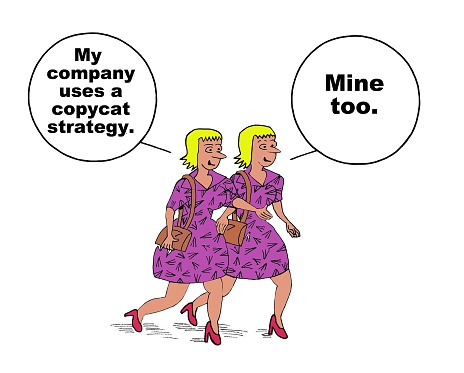Unveiling the Origins of Copycat Products: Understanding Imitation in the Business World
Introduction
Copycat products, often referred to as “knock-offs” or “counterfeits,” have become a prevalent and controversial aspect of the global market. These products imitate the design, packaging, or branding of well-known and successful items, aiming to ride on the coattails of the original product’s success. Understanding the origins of copycat products sheds light on the motivations and challenges posed by this phenomenon in the business world.

Historical Roots of Copycat Products
The concept of copying and imitating products is not a new phenomenon. Throughout history, artisans, craftsmen, and traders have reproduced and sold replicas of popular goods. In ancient civilizations, such as the Roman and Chinese empires, counterfeit goods were a common occurrence, mimicking luxury items and artwork.
With the advent of the Industrial Revolution in the 18th and 19th centuries, mass production made it easier for unscrupulous businesses to produce and distribute copycat products. As globalization expanded in the 20th century, counterfeiting became even more widespread, facilitated by advancements in technology and the ease of international trade.
Motivations Behind Copycat Products
The motivations behind copycat products, also known as knock-offs or counterfeits, are multifaceted and influenced by various economic, social, and legal factors. Understanding these motivations helps shed light on why copycat products persist in the global market. Some of the key motivations behind copycat products include:
- Profit Maximization: One of the primary motivations for producing copycat products is the pursuit of profits. Counterfeiters seek to capitalize on the popularity and demand for well-known brands and products without incurring the costs of research, development, and marketing. By selling imitations at a lower price, they attract price-sensitive consumers, leading to increased sales and revenue.
- Affordability and Price Sensitivity: Consumers are often attracted to copycat products due to their lower price compared to the original brands. Many consumers seek affordable alternatives to premium products, and copycat products provide an option to own something that resembles a luxury item at a fraction of the cost.
- Market Demand and Supply: The demand for copycat products is driven by consumer preferences and trends. If certain brands or products become highly popular and unattainable for some consumers due to their high prices, the demand for more affordable alternatives increases, leading to a thriving counterfeit market.
- Lack of Access to Original Brands: In some regions or countries, access to original branded products may be limited due to various reasons, such as distribution challenges or high import costs. As a result, consumers may turn to copycat products as a readily available option.
- Cultural and Social Aspirations: Copycat products often target consumers who aspire to own prestigious or high-status brands but cannot afford the genuine products. Purchasing copycat products allows them to fulfill their social and cultural aspirations to some extent.
- Perceived Similarity: Copycat products are designed to closely resemble the appearance, packaging, and branding of original products. Consumers may be attracted to these imitations because they believe the copycat product is almost indistinguishable from the original, allowing them to enjoy a similar product experience without paying a premium.
- Lack of Awareness or Ignorance: Some consumers may unknowingly purchase copycat products without realizing they are counterfeit. They might believe they are purchasing genuine products at a discounted price, especially if they are not familiar with the original brand or its authentic products.
- Weak Intellectual Property Protection: In regions with weak intellectual property laws or enforcement, counterfeiters face fewer legal consequences, making it easier for them to operate and profit from selling copycat products.
- Evasion of Regulations and Taxes: Counterfeiters often operate in the informal economy, avoiding taxes and regulations that legitimate businesses are subject to. This provides them with a cost advantage over authentic brands.
- Ease of Production and Distribution: Technological advancements and globalized supply chains make it easier for counterfeiters to produce and distribute copycat products on a large scale, increasing their accessibility to consumers.
Several factors contribute to the emergence of copycat products:
- Profit Motive: One of the primary drivers of copycat products is the pursuit of profit. Counterfeiters aim to capitalize on the popularity of well-established brands without investing in research, development, or marketing. By offering cheaper alternatives, they attract price-sensitive consumers.
- Demand for Affordability: Copycat products often appeal to budget-conscious consumers who desire products resembling premium brands at a fraction of the cost. This demand drives counterfeit markets, particularly in fashion, electronics, and luxury goods.
- Low Risk and High Reward: The production and sale of counterfeit goods can be a lucrative but illegal business. The relatively low cost of manufacturing counterfeit products, combined with high demand, creates an enticing opportunity for illicit entrepreneurs.
- Lack of Intellectual Property Protection: In some regions, weak or ineffective intellectual property laws make it easier for counterfeiters to operate without facing significant consequences.
- Consumer Perception: Consumers may not always be aware that they are purchasing counterfeit products, especially if the imitation is skillfully executed. As a result, the counterfeit market thrives on unwitting consumers.
Challenges Posed by Copycat Products
The rise of copycat products presents numerous challenges for businesses, consumers, and the economy at large:
- Brand Reputation: Copycat products can tarnish the reputation of legitimate brands. Inferior quality counterfeit goods can lead to dissatisfied customers who associate their negative experience with the original brand.
- Economic Impact: Counterfeit products can harm the economy by undermining legitimate businesses, leading to revenue loss, layoffs, and reduced investments in innovation.
- Product Safety and Quality: Copycat products are often produced without adhering to safety and quality standards. This poses significant risks to consumer health and safety.
- Intellectual Property Theft: Counterfeiting infringes upon intellectual property rights, discouraging companies from investing in research and development, innovation, and new product design.
- Law Enforcement Challenges: The widespread nature of counterfeiting makes it difficult for law enforcement to combat effectively. Identifying and prosecuting counterfeiters requires significant resources and international cooperation.
Conclusion
The origins of copycat products can be traced back to the early days of commerce, but their prevalence has increased in the modern global marketplace. Driven by the pursuit of profit, consumer demand for affordability, and weak intellectual property protections, counterfeit products pose significant challenges for legitimate businesses, consumers, and the economy. Addressing this issue requires a multi-faceted approach involving enhanced intellectual property enforcement, consumer education, and global cooperation to safeguard the integrity of the marketplace and protect the interests of all stakeholders.
The motivations behind copycat products are driven by a combination of profit-seeking, consumer demand for affordability, weak enforcement of intellectual property rights, and cultural aspirations. While these imitations may appear to offer advantages to some consumers in the short term, they can lead to adverse effects on legitimate businesses, consumer safety, and the overall economy. Addressing the issue of copycat products requires a coordinated effort from governments, businesses, and consumers to enforce intellectual property rights, raise awareness about counterfeit goods, and promote ethical consumption practices.







